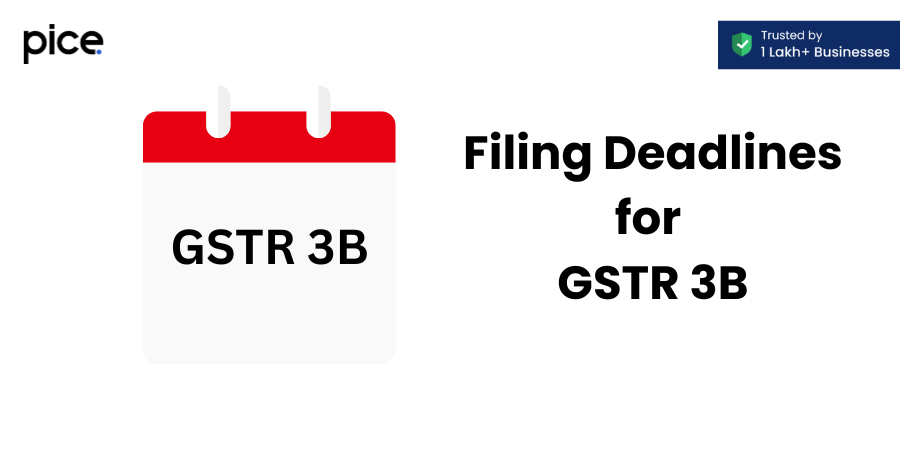Key Takeaways
- GSTR-3B is a mandatory self-declared summary GST return that must be filed regularly by registered businesses to report their tax liabilities.
- Filing GSTR-3B after the due date incurs late fees and interest, emphasizing the importance of timely submission.
- Taxpayers with an annual turnover up to ₹5 crore can opt for the Quarterly Return Monthly Payment (QRMP) scheme, filing GSTR-3B quarterly.
- Extensions of GSTR-3B deadlines have been periodically granted to provide relief to taxpayers, especially during the COVID-19 pandemic.
- Failure to file GSTR-3B on time can lead to blocked e-way bills and suspension of GST registration, highlighting the need for compliance.
Under the current GST regime, adhering to GST return due dates is essential for taxpayers to fulfil their tax obligations by filing GST returns and submitting prescribed forms. Failing to meet these deadlines may result in penalties and accrual of interest charges. In this blog, we provide a comprehensive guide on the extended GSTR-3B due dates over the years.
Understanding GSTR-3B
GSTR-3B is a self-declared summary GST return that registered businesses must regularly file to report details such as figures of sales, input tax credit (ITC) claims, net tax payable, refunds and other details associated with their GSTIN. This form, alongside GSTR-1 and GSTR-2, provides a consolidated overview of inward and outward taxable supplies. Through this form, taxpayers can summarise their GST liabilities for a relevant period.
Each registered entity with a valid GSTIN is required to file a separate GSTR-3B, ensuring that all GST liabilities are settled prior to submission. Even if there is no tax liability, it is mandatory to file GSTR-3B. Once submitted, revisions to GSTR-3B are not permitted.
Steps to File Form GSTR 3B
The following is a stepwise process on how to fill Form GSTR-3B online using the official portal.
Step 1: Navigate to the official GST portal and log in with your registered credentials.
Step 2: On the homepage, locate the ‘Services’ tab.
Step 3: Choose the ‘Returns’ option.
Step 4: Click on ‘Returns Dashboard’.
Step 5: You will be redirected to the ‘File Returns’ page. Specify the ‘Financial Year’, ‘Quarter’ and ‘Return Filing Period – Month or Quarter’ for which you want to file the return from the drop-down list.
Step 6: Tap on the ‘SEARCH’ button.
Step 7: Find the option marked ‘GSTR 3B Monthly Returns’ and click on it.
Step 8: Hit the ‘PREPARE ONLINE’ tab.
Step 9: Go through the list of questions and enter the required details carefully.
Step 10: Click on ‘NEXT’.
Step 11: Select ‘Yes’ in the first question and proceed with the remaining ones accordingly if you have Nil tax liability.
Step 12: Enter applicable values in the displayed tiles, filling in interest and late fees where necessary. Ensure totals are entered under each applicable head.
Step 13: Click either the ‘Add’ or ‘Delete’ option to make necessary modifications in each tile.
Step 14: Click on ‘Confirm’.
Step 15: Tap on the ‘SAVE GSTR 3-B’ button.
Step 16: Verify all the provided details and click on the ‘SUBMIT’ tab.
Step 17: Click ‘Preview Draft GSTR-3B’ to view the draft GSTR-3B return.
Step 18: Upon successful submission of the return, the ‘Payment of Tax’ tile will be enabled. Taxpayers can then click on the ‘Check Balance’ button to view the cash and credit balance.
Step 19: A drop-down list will appear on your screen. Choose the ‘Authorised Signatory’ option.
Step 20: Click on the ‘FILE GSTR-3B WITH DSC/FILE GSTR-3B WITH EVC’ option.
Step 21: Tap on the ‘Proceed’ button.
After following these steps accurately, a message confirming the successful submission of the form will be displayed on the screen. Click ‘OK’ to proceed. Subsequently, the status will change to ‘Filed’.
GSTR-3B Filing Deadlines

Taxpayers not under the composition scheme must file the monthly summary return GSTR-3B. Starting from January 1, 2021, taxpayers with an annual aggregate turnover of up to ₹5 crore, opting for the QRMP scheme, have the option to file the GSTR-3B quarterly returns.
- Deadline Filing for Taxpayers with Aggregate Turnover Exceeding ₹5 Crore in the Previous Financial Year
| Month | Due Date |
| April 2024 | 20th May 2024 |
| May 2024 | 20th June 2024 |
| June 2024 | 20th July 2024 |
| July 2024 | 20th August 2024 |
| August 2024 | 20th September 2024 |
| September 2024 | 20th October 2024 |
💡If you want to pay your GST with Credit Card, then download Pice Business Payment App. Pice is the one stop app for all paying all your business expenses.
- Deadline Filing for Taxpayers Under QRMP Scheme
| Quarter | Due date |
| April-June 2024 | For category X states/UT: 22nd July 2024 |
| For category Y states/UT: 24th July 2024 | |
| July-September 2024 | For category X states/UT: 22nd October 2024 |
| For category Y states/UT: 24th October 2024 | |
| Category X: Chhattisgarh, Madhya Pradesh, Gujarat, Maharashtra, Karnataka, Goa, Kerala, Tamil Nadu, Telangana, Andhra Pradesh, the Union Territories of Daman and Diu and Dadra and Nagar Haveli, Puducherry, Andaman and Nicobar Islands and Lakshadweep. | |
| Category Y: Himachal Pradesh, Punjab, Uttarakhand, Haryana, Rajasthan, Uttar Pradesh, Bihar, Sikkim, Arunachal Pradesh, Nagaland, Manipur, Mizoram, Tripura, Meghalaya, Assam, West Bengal, Jharkhand, Odisha, the Union Territories of Jammu and Kashmir, Ladakh, Chandigarh and New Delhi. | |
Extended Deadlines for Filing Form GSTR-3B Returns
On September 11, 2018, it was noted that more taxpayers were filing GSTR-3B compared to GSTR 1. As a result, due dates were extended to help taxpayers meet their filing obligations. The extended deadlines vary, depending upon the taxpayer type.
Regular Taxpayers
The due date for GSTR 3B remains the 20th of the following month for regular taxpayers.
Newly Migrated Taxpayers
Newly migrated taxpayers, who received provisional IDs and recently obtained GST registration, need to file GSTR-3B every month from July 2017 to November 2018, with the deadline extended to December 31, 2018.
Special Extensions for Certain States
Taxpayers with turnover up to ₹1.5 crore who have opted for quarterly filing and are located in the State of Kerala, Kodagu district in Karnataka and Mahe in Pondicherry were granted a special extension for filing GSTR-3B for the quarter July 2018 to September 2018, with the deadline extended to November 30, 2018.
Late Fee Waiver

On June 30, 2020, the Central Board of Indirect Taxes and Customs (CBIC) issued GST Notification No. 57/2020, capping late fees for GSTR-3B filings for all categories of taxpayer, regardless of turnover.
| GST Liability | Tax Period | Failed to File Within | Filed Within | Late Fees |
| Nil | July 17 to January 20 | Actual due date | 1st July 20 to 30th September 20 | Zero |
| Other than Nil | July 17 to January 20 | Actual due date | 1st July 20 to 30th September 20 | ₹500 |
| Nil | February 20 to July 20 | Later of actual due date or specified dates | Later of actual due date or specified dates to 30th September 20 | Zero |
| Other than Nil | February 20 to July 20 | Later of actual due date or specified dates | Later of actual due date or specified dates to 30th September 20 | ₹500 |
The extension of return filing dates was specifically to waive the late fees applicable for delay in filing. It is important to note that these are not just simply due date extensions but deadlines to file returns without incurring late fees.
GSTR-3B Return Form
In response to the challenges faced by taxpayers during the COVID-19 pandemic, the CBIC issued a series of notifications and circulars to provide relief to normal taxpayers filing GSTR-3B.
- In the case of taxpayers with turnover above ₹5 crore
Relief in terms of late fee waiver and nil interest was provided for February to April, as long as the filing was done within the extended dates for return filing. For the remaining tax periods, these reliefs do not apply.
| Tax Period | Due Date for Filing Returns Without Relief | Waived Late Fees (if filed within specified dates) | Nil Interest (if filed within specified dates and @9% thereafter till 24th June |
| February 20 | 20th March 2020 | 24th June 2020 | 4th April 2020 (15 days from due date) |
| March 20 | 20th April 2020 | 5th May 2020 (15 days from due date) | |
| April 20 | 20th May 2020 | 4th June 2020 (15 days from due date) | |
| May 20 | 27th June 2020 | No Relief | No Relief |
| June 20 | 20th July 2020 | ||
| July 20 | 20th August 2020 |
- In the case of taxpayers with a turnover limit of up to ₹5 crore in Category X states/UTs
Late fees are waived if the returns are filed within the following dates. Interest is nil if returns are filed within the specified dates, and at 9% thereafter until September 30.
| Tax Period | Due Date for Filing Returns Without Relief | Specified Dates |
| February-20 | 22nd March 2020 | 30th June 2020 |
| March-20 | 22nd April 2020 | 3rd July 2020 |
| April-20 | 22nd May 2020 | 6th July 2020 |
| May-20 | 12th July 2020 | 12th September 2020 |
| June-20 | 22nd July 2020 | 23rd September 2020 |
| July-20 | 22nd August 2020 | 27th September 2020 |
| Category X: Chhattisgarh, Madhya Pradesh, Gujarat, Maharashtra, Karnataka, Goa, Kerala, Tamil Nadu, Telangana, Andhra Pradesh, the Union Territories of Daman and Diu and Dadra and Nagar Haveli, Puducherry, Andaman and Nicobar Islands and Lakshadweep. | ||
- In the case of taxpayers with a turnover limit of up to ₹5 crore in Category Y states/UTs:
Late fees are waived if returns are submitted by the following specified dates. Interest is nil for timely filings and rises to 9% if submitted after the specified dates, up until September 30.
| Tax Period | Due Date for Filing Returns Without Relief | Specified Dates |
| February-20 | 24th March 2020 | 30th June 2020 |
| March-20 | 24th April 2020 | 5th July 2020 |
| April-20 | 24th May 2020 | 9th July 2020 |
| May-20 | 14th July 2020 | 15th September 2020 |
| June-20 | 24th July 2020 | 25th September 2020 |
| July-20 | 24th August 2020 | 29th September 2020 |
| Category Y: Himachal Pradesh, Punjab, Uttarakhand, Haryana, Rajasthan, Uttar Pradesh, Bihar, Sikkim, Arunachal Pradesh, Nagaland, Manipur, Mizoram, Tripura, Meghalaya, Assam, West Bengal, Jharkhand or Odisha, the Union Territories of Jammu and Kashmir, Ladakh, Chandigarh and Delhi. | ||
GSTR-1 Form
The late fees for GSTR-1 were waived if filed within the specified dates for regular taxpayers. However, to benefit from this waiver, taxpayers with up to an annual ₹5 crores turnover had to specify their filing preference for the FY 2020-21 on the GST portal.
| GST Return Type | Tax Period | Extended Dates |
| Monthly Filing | March-20 | 10th July 2020 |
| Monthly Filing | April-20 | 24th July 2020 |
| Monthly Filing | May-20 | 28th July 2020 |
| Monthly Filing | June-20 | 5th August 2020 |
| Quarterly Filing | March-20 | 17th July 2020 |
| Quarterly Filing | June-20 | 3rd August 2020 |
Extension of E-way Bill Validity Period
According to GST Notification 39/2020, e-way bills generated on or before March 24, 2020, with validity expiring between March 20, 2020, and April 15, 2020, will remain valid until May 31, 2020.
The Bottom Line
Over the years, the CBIC has periodically extended GSTR-3B due dates, providing crucial relief to taxpayers to ensure they can manage their tax and business compliances effectively and avoid financial penalties associated with late filings. As of now, monthly filers must file Form GSTR-3B by the 20th day of the following month, while quarterly filers have deadlines on the 22nd or 24th day of the subsequent quarter.
FAQs
Can GSTR 3B be filed after the due date?
Yes, GSTR 3B can be filed after the due date, but late fees and interest will apply for the delay. It’s crucial to file as soon as possible to minimize these penalties and avoid complications with GST compliance.
What is the max penalty for late filing of GSTR 3B?
The maximum penalty for late filing of GSTR 3B includes a late fee of Rs. 50 per day (Rs. 25 each for CGST and SGST) or Rs. 20 per day (Rs. 10 each for CGST and SGST) for nil returns, subject to a cap based on the total tax liability. Additionally, interest at 18% per annum may be charged on the outstanding tax amount.
What happens if GSTR 3B is not filed on time?
If GSTR 3B is not filed on time, the taxpayer will incur late fees and interest on the outstanding tax. Continued non-compliance can lead to further legal consequences, including the blocking of e-way bills and suspension of GST registration.
Is the GST annual return date extended?
The extension of the GST annual return date varies each year based on government notifications. Taxpayers should check the latest updates from the GST portal or official announcements for the current status on any extensions.
What is the due date for GST extension?
The due date for GST return filing extensions, including GSTR 3B and annual returns, is announced by the government based on specific circumstances. Taxpayers should regularly check official notifications from the GST portal for accurate information.
Is GSTR 3B monthly or quarterly?
GSTR 3B is generally a monthly return for regular taxpayers, but small taxpayers with a turnover of up to Rs. 5 crores can opt for the Quarterly Return Monthly Payment (QRMP) scheme, filing GSTR 3B quarterly with monthly payments.
What is the difference between GSTR 3 and GSTR 3B?
GSTR 3 is a detailed monthly return that consolidates the information provided in GSTR 1 and GSTR 2, while GSTR 3B is a simplified summary return used for the initial period of GST implementation. GSTR 3B serves as a temporary solution to report total values and pay taxes until GSTR 3 becomes fully operational








